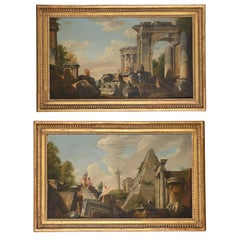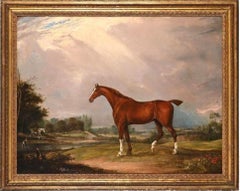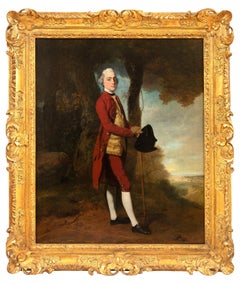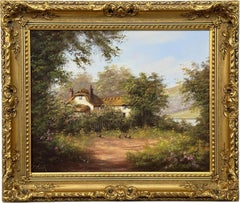Isherwood Fine Art Ltd Landscape Paintings
to
2
3
1
Overall Width
to
Overall Height
to
2
2
2
1
3
1
2
2
2
1
1
1
4
4
4
4
1
1
1
4
4
A pair of 18th century Italian landscapes with classical ruins and figures
By Giovanni Paolo Panini
Located in Bath, Somerset
A pair of 18th century Italian landscapes with classical ruins and figures, circa 1750.
Circle of Giovanni Panini (1691-1765)
Thomas Agnew and Sons, Lo...
Category
18th Century Old Masters Landscape Paintings
Materials
Canvas, Oil
English early 19th century painting of a chestnut hunter in a landscape
By John Ferneley Senior
Located in Bath, Somerset
A painting of a chestnut hunter in a landscape with a horse and rider accompanied by two hounds by a woodland river in the distance.
Signed and inscribed 'Melton Mowbray', lower left.
Oil on canvas in a giltwood frame.
John Ferneley Sr (1782-1860) was born the son of a Leicestershire wheelwright, the youngest of six children. He is known as one of the great British equine artists, perhaps only second to Stubbs in terms of raw ability.
Ferneley originally worked with his father, until by chance the Duke of Rutland saw some of his work on the side of a cart on which Ferneley and his father had been working. The Duke was so impressed with Ferneley that he persuaded John's father to allow him to become the pupil of Benjamin Marshall. Ferneley was so talented that apparently he produced almost perfect copies of his tutor's paintings and they were said to have been indistinguishable from the master’s. Marshall also enrolled him as a student of the Royal Academy Schools.
In 1804 Ferneley paid a man named Thomas Harrison...
Category
Early 19th Century English School Animal Paintings
Materials
Canvas, Oil
An English 18th century portrait of James Stanley, standing in a landscape
By John Hamilton Mortimer
Located in Bath, Somerset
Portrait of James Stanley (1750 - 1810), circa 1775-1778, full-length, wearing a red coat and breeches and a gold embroidered waistcoat, hold...
Category
1770s English School Portrait Paintings
Materials
Canvas, Oil, ABS
19th century English School, Bay Horse and a Terrier in a Landscape
Located in Bath, Somerset
A bay hunter and a black and white short haired dog (possibly a bull terrier) in an extensive English landscape. a rustic barn in the near distance. Indistinctly signed 'Br...' and d...
Category
Early 19th Century English School Animal Paintings
Materials
Canvas, Oil
$9,330 Sale Price
20% Off
Related Items
Cottage in a Lush Garden with Hens in the English Countryside by British Artist
Located in Preston, GB
Cottage in a Lush Garden with Hens in the English Countryside by 20th Century British Artist, Terry Heath (1943-2011)
Art measures 20 x 16 inches
Frame measures 26 x 22 inches
S...
Category
1980s English School Landscape Paintings
Materials
Canvas, Cotton Canvas, Oil
$1,776 Sale Price
30% Off
H 22 in W 26 in D 2.5 in
Shepherd with Sheep, Cows and a Goat in a Landscape by Jan Frans Soolmaker
Located in Stockholm, SE
Jan Frans Soolmaker (Flanders 1635‑1685)
Shepherd with Sheep, Cows and a Goat in a Landscape
oil on relined canvas
canvas size 56 x 53 cm
frame i...
Category
17th Century Old Masters Animal Paintings
Materials
Canvas, Oil
$5,791 Sale Price
25% Off
H 22.05 in W 20.87 in
Landscape Near Felday, Surrey
By Abraham Hulk the Younger
Located in Hillsborough, NC
Dutch/English artist Abraham Hulk the Younger (1851-1922) is most known for landscapes of the British countryside. This work is one of a pair (the second work is also available by s...
Category
Late 19th Century Old Masters Landscape Paintings
Materials
Canvas, Oil
$2,240 Sale Price
20% Off
H 27 in W 22.75 in D 2.13 in
Shipping in Stormy Waters, Attributed to Italian Artist Francesco Guardi
By Francesco Guardi
Located in Stockholm, SE
The splendour of the tragic sea
Francesco Guardi and maritime painting in Venetian art
No Venetian painter was a stranger to the sea. After all, Venice was not only one of the most prominent ports of the Mediterranean, but indeed a city literally submerged in the ocean from time to time. Curiously however, the famous Venetian school of painting showed little interest in maritime motifs, favouring scenes from the iconic architecture of the city rather than seascapes. That is why this painting is a particularly interesting window into not only the painter Francesco Guardi himself – but to the significance of the element of water in art history, in absence as well as in the centre of attention.
Whether it be calm, sunny days with stunning views of the palaces alongside the canals of Venice or – more rarely – stormy shipwrecking tragedies at sea, water as a unifying element is integral to the works of painter Francesco Guardi (1712–1793). During his lifetime, Venetian art saw many of its greatest triumphs with names like Tiepolo or Canaletto gaining international recognition and firmly establishing Venice as one of the most vibrant artistic communities of Europe. While the city itself already in the 18th century was something of an early tourist spot where aristocrats and high society visited on their grand tour or travels, the artists too contributed to the fame and their work spread the image of Venice as the city of romance and leisure to an international audience, many of whom could never visit in person.
Still today, the iconic image of Venice with its whimsical array of palaces, churches and other historic buildings is much influenced by these artists, many of whom have stood the test of time like very well and remain some of the most beloved in all of art history. It was not primarily subtility, intellectual meanings or moral ideals that the Venetian art tried to capture; instead it was the sheer vibrancy of life and the fast-paced city with crumbling palaces and festive people that made this atmosphere so special. Of course, Venice could count painters in most genres among its residents, from portraiture to religious motifs, history painting and much else. Still, it is the Vedutas and views of the city that seems to have etched itself into our memory more than anything else, not least in the tradition of Canaletto who was perhaps the undisputed master of all Venetian painters.
Born into his profession, Francesco lived and breathed painting all his life. His father, the painter Domenico Guardi (1678–1716) died when Francesco was just a small child, yet both he and his brothers Niccolò and Gian Antonio continued in their fathers’ footsteps. The Guardi family belonged to the nobility and originated from the mountainous area of Trentino, not far from the Alps. The brothers worked together on more challenging commissions and supported each other in the manner typical of family workshops or networks of artists. Their sister Maria Cecilia married no other than the artist Giovanni Battista Tiepolo himself, linking the family to the most renowned Venetian name of the time. During almost a decade, Guardi worked in the studio of Michele Giovanni Marieschi, sometimes simply known as Michiel, a painted similar in both style and motif. Canaletto is, however, the artist Guardi is most often compared to since they shared a mutual fascination for depicting the architecture and cityscape of Venice.
During the course of his career, Guardi tried his hand in many different genres. He was as swift in painting landscapes, Vedutas of Venice, sacred motifs, interiors and architectural compositions as he was in a number of other motifs. His style is typical of the Venetian school but also distinct and personal once we look a little closer. There is an absolute certainty in the composition, the choice of which sometimes feels like that of a carefully calculated photograph – yet it is also very painterly, in the best sense of the word: fluid, bold, sensitive and full of character. The brushwork is rapid, intense, seemingly careless and extraordinarily minute at the same time; fresh and planned in a very enjoyable mixture. His interiors often capture the breath-taking spacious glamour of the palaces and all their exquisite decor. He usually constructed the motif through remarkably simple, almost spontaneous yet intuitively precise strokes and shapes. The result was a festive, high-spirited atmospheric quality, far away from the sterile and exact likeness that other painters fell victim to when trying to copy Canaletto.
The painting here has nothing of the city of Venice in it. On the contrary, we seem to be transported far away into the solitary ocean, with no architecture, nothing to hold on to – only the roaring sea and the dangerous cliffs upon which the ships are just moments away from being crushed upon. It is a maritime composition evoking both Flemish and Italian precursors, in the proud tradition of maritime painting that for centuries formed a crucial part of our visual culture.
This genre of painting is today curiously overlooked, compared to how esteemed and meaningful it was when our relationship to the sea was far more natural than it is today. When both people and goods travelled by water, and many nations and cities – Venice among them – depended entirely on sea fare, the existential connection to the ocean was much more natural and integrated into the imagination. The schools and traditions of maritime art are as manifold as there are countries connected to the sea, and all reflect the need to process the dangers and wonders of the ocean.
It could symbolize opportunity, the exciting prospects of a new countries and adventures, prospering trade, beautiful scenery as well as war and tragedy, loss of life, danger and doom. To say that water is ambivalent in nature is an understatement, and these many layers were something that artists explored in the most wondrous ways. Perhaps it takes a bit more time for the modern eye to identify the different nuances and qualities of historic maritime paintings, they may on first impression seem hard to differentiate from each other. But when allowing these motifs to unfold and tell stories of the sea in both fiction and reality – or somewhere in between – we are awarded with an understanding of how the oceans truly built our world.
In Guardi’s interpretation, we see an almost theatrically arranged shipwrecking scene. No less than five ships are depicted right in the moment of utter disaster. Caught in a violent storm, the waves have driven them to a shore of sharp cliffs and if not swallowed by the waves, crushing against the cliffs seems to be the only outcome. The large wooden ships are impressively decorated with elaborate sculpture, and in fact relics already during Guardi’s lifetime. They are in fact typical of Dutch and Flemish 17th century ships, giving us a clue to where he got the inspiration from. Guardi must have seen examples of Flemish maritime art, that made him curious about these particular motifs. One is reminded of Flemish painters like Willem van de Velde and Ludolf Backhuysen, and this very painting has indeed been mistakenly attributed to Matthieu van Plattenberg...
Category
18th Century Old Masters Landscape Paintings
Materials
Canvas, Oil
$47,400 Sale Price
32% Off
H 25.79 in W 29.14 in
Antique English Oil Painting Sheep in Pastoral Landscape Golden Light
Located in Cirencester, Gloucestershire
Pastoral Landscape
English School, late 19th century
signed
oil on board, framed
framed: 19 x 25 inches
board: 18 x 24 inches
Provenance: private collection, UK
Condition: the painti...
Category
Late 19th Century English School Landscape Paintings
Materials
Canvas, Oil
$1,166
H 19 in W 25 in
Traditional English Farm with Horses, Figures, Trees & Lake by British Artist
Located in Preston, GB
English Farmhouse with Horses, Figures, Fields, Trees & Lake entitled 'Winters Morn' by 20th Century British Artist.
Art measures 36 x 24 inches
Frame measures 41 x 30 inches
Ch...
Category
Late 20th Century Photorealist Landscape Paintings
Materials
Canvas, Oil
$2,161 Sale Price
30% Off
H 30 in W 41 in D 2.5 in
Terriers in Stable Barn Interior Rat Catching Signed 1920's English Oil Painting
Located in Cirencester, Gloucestershire
The Rat Catcher
English School, 1920's
signed, dated, "R. Esom"
oil on canvas, framed
framed: 12 x 16 inches
canvas : 8 x 12 inches
Provenance: private collection, Cotswolds, Englan...
Category
1920s English School Animal Paintings
Materials
Oil
English 1950's Sporting Art Oil Painting Portrait of Horse in Landscape
Located in Cirencester, Gloucestershire
Portrait of a Horse in a Landscape
English artist, mid 20th century
indistinctly signed oil on board,
framed: 14.5 x 18.5 inches
board: 12 x 16 inches
provenance: private collection...
Category
Mid-20th Century English School Animal Paintings
Materials
Oil
$1,680
H 14.5 in W 18.5 in
Scottish Keeper’s Pony and Hunting Dogs
By John Gifford
Located in Hillsborough, NC
Scottish/British artist John Gifford (19th century to 1900) is best known for his hunting dogs, pack Ponies, setters and spaniels in the Scottish countryside and highlands. Sought...
Category
19th Century English School Animal Paintings
Materials
Canvas, Oil
Border Collie Dog Resting in Harvest Wheat Sheaves Antique English Oil Painting
Located in Cirencester, Gloucestershire
The Farmers Dog
English School, early 20th century
signed oil on board, framed
framed: 23 x 29 inches
board : 18 x 24 inches
Provenance: private collection, UK
Condition: very good c...
Category
Early 20th Century English School Animal Paintings
Materials
Oil
Portrait of the Long-Haired Black Labrador, 19th Century, English School
By John Ferneley Senior
Located in Firenze, IT
Portrait of the Long-Haired Black Labrador, 19th Century, English School
This distinguished portrait of a long-haired black Labrador is attributed to the circle of John Ferneley (18...
Category
19th Century English School Animal Paintings
Materials
Canvas, Oil
$1,900 Sale Price
36% Off
H 23.63 in W 26.78 in
The Knight - painting - XVII century
Located in Roma, IT
The Knight is an original oil painting on canvas realized during the XVII century by an anonymous artist.
Provenance: Pecci-Blunt collection. Good condition...
Category
17th Century Old Masters Figurative Paintings
Materials
Canvas, Oil





